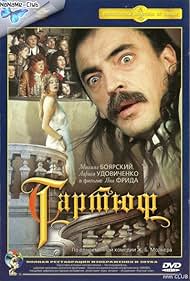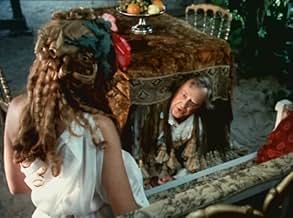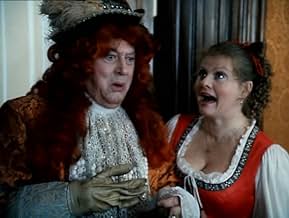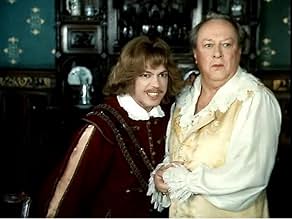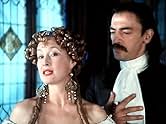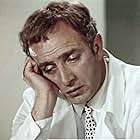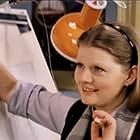Aggiungi una trama nella tua linguaTartuffe is hidden behind a mask of humility and fear of God. And there's a lot of people to believe that he's truly like that.Tartuffe is hidden behind a mask of humility and fear of God. And there's a lot of people to believe that he's truly like that.Tartuffe is hidden behind a mask of humility and fear of God. And there's a lot of people to believe that he's truly like that.
Trama
Lo sapevi?
- ConnessioniVersion of Tartufo (1925)
Recensione in evidenza
The musical. The film adaptation of the comedy "Tartuffe, or the Deceiver" by the famous French comedian Moliere, directed by the famous Soviet director Yan Borisovich Frid, for whom this work was the last in his film career. And, since I have not read the original book source, I will evaluate the film adaptation as an independent work. I decided to view this picture, because I really liked the work of Jan Fried (Dog in the manger, Bat, Pious Marta, Silva, Don Cesar de Bazan - they won't let me lie), and curiosity was not the last of the reasons. As a result, I watched it and was very disappointed, especially by the director. And here's my brief opinion for you - A typical movie of "Free" Russia of the nineties. There were both pros (which are few) and cons in the picture, and I intend to highlight them all. And with that, we'll finish the much-needed introduction and get to the point.
So, the pros: 1. Tartuffe (Boyarsky) is just a divine hit in the image. It is even difficult to imagine a better Tartuffe (a scoundrel, a scoundrel and a fraud hiding behind the image of a saint). And the performance of the song about fools by Mikhail Boyarsky is just the quintessence of this image. The charisma of the actor and his talent are perfect here, because his Tartuffe can be seen even in the wonderful picture about the Musketeers of 1979. A talent that can transform in the blink of an eye from an immaculate angel into an insidious devil who doesn't care about anything and everyone except himself. Boyarsky does not play here - he lives here Tartuffe. And the moral of the whole story is very true (about eternal temptations and eternal struggle with them), because this name has long been a household name, and comedies about this character are still very popular to this day.
2. Costumes and decorations - Pavlovsk and Oranienbaum played the role of France here, namely the palaces and parks of Russian sovereigns, whose furnishings are very similar to Western European (which is not surprising, because they were designed by European architects). And the great costumes of the seventeenth century sit perfectly on the actors. With this, Jan Fried's paintings have always been good, and the costumers and decorators knew their business, for which they have my respect. And all this creates the atmosphere of France of those years.
So, the cons: 1. Songs - apart from the song about fools performed by Boyarsky, there is really nothing here. Which is unacceptable for Jan Fried, because he shot musical pictures where songs played far from the last role, and often went to the people, which is not observed here from the word at all. Empty monosyllabic motifs, boring texts and sung without a drop of effort. Sorry, but this is a failure, especially for such a master of musical cinema as Jan Fried!
2. Boredom - the picture goes on for only an hour and a half, but not every viewer will sit them out (not to mention the snobby critics (unless they were brought in)). I tried to turn it off myself five times, but an unknown force forced me to continue watching (please write me a medal "For Bravery" someone!). All the characters (except Tartuffe) were not hooked, even despite the color of celebrities (Vladislav Strzhelchik, Larisa Udovichenko, Igor Dmitriev, Anna Samokhina and so on). And this is entirely the fault of the director, who could not use the talent of these wonderful actors in all its splendor.
3. Vulgarity - "O tempora! O mores!" as Cicero said. The picture shows the reflection of the tragedy of the early nineties - poverty, scarcity, and "freedom" in all imaginable and unthinkable forms. No, the characters don't talk directly about vulgarity, but the camera, gestures, glances, the almost half-naked heroine Udovichenko, the betrayal that almost happened (I'm not talking about the "charms" of the heroine Irina Muravyeva, who actively uses them). I'm sorry, but this is beyond the limit. To roll everything into banal vulgarity, which is out of place here. The "Free" Russia of the nineties is immediately visible, where there are no forbidden topics, and where this could already be shown on the screens of the country, after all, the picture was shot back in 1991 at the expense of the Soviet Union living out the last months.
A little about the main characters: 1. Tartuffe, performed by Mikhail Boyarsky, is an upstart, a scoundrel, a scoundrel hiding behind a mask of holiness and skillfully fooling his patron, the aristocrat Orgon. I have already written praises to the actor for his excellent (no fools) acting and masterful reincarnation, so I see no point in repeating myself. Truly, only Mikhail Boyarsky pleased both the eye and the ear here! Bravo!
2. Orgon performed by Vladislav Strzhelchik is an aristocrat and the head of the family who sheltered Tartuffe and believes him as a brother. Rejects all slander against him. A typical representative of a kind of people who have always been called "fools" and who are very difficult to correct (and sometimes it is impossible at all), who was well played by the famous Vladislav Strzhelchik, for whom this image is a real reincarnation ("His Excellency's Adjutant" will not let you lie).
3. Elmira, performed by Larisa Udovichenko, is the seductive wife of Orgon, whom Tartuffe intends to seize at any cost, and she uses her beauty in every possible way for personal (and not only) purposes. Larisa's outfits are beautiful, and she succeeded in the role, there's nothing to scold for, but she can't outshine Boyarsky.
This picture was the last work of director Jan Fried, after which he ended his career, which began in 1939 with the picture "Patriot" (about a patriot boy of the thirties). Apparently he realized that "Tartuffe" was not so good. His weakest work, but there are many others that the audience likes to review and empathize with their heroes again, and you can't say that about "Tartuffe". Pity!
As a result, we have the weakest picture of the master of musical cinema, Jan Fried, with a good script, the right morality, good costumes and scenery, but with immeasurable vulgarity and a lot of repulsive moments, but with good acting.
My rating is 5 out of 10 and I do not recommend this picture for viewing!
So, the pros: 1. Tartuffe (Boyarsky) is just a divine hit in the image. It is even difficult to imagine a better Tartuffe (a scoundrel, a scoundrel and a fraud hiding behind the image of a saint). And the performance of the song about fools by Mikhail Boyarsky is just the quintessence of this image. The charisma of the actor and his talent are perfect here, because his Tartuffe can be seen even in the wonderful picture about the Musketeers of 1979. A talent that can transform in the blink of an eye from an immaculate angel into an insidious devil who doesn't care about anything and everyone except himself. Boyarsky does not play here - he lives here Tartuffe. And the moral of the whole story is very true (about eternal temptations and eternal struggle with them), because this name has long been a household name, and comedies about this character are still very popular to this day.
2. Costumes and decorations - Pavlovsk and Oranienbaum played the role of France here, namely the palaces and parks of Russian sovereigns, whose furnishings are very similar to Western European (which is not surprising, because they were designed by European architects). And the great costumes of the seventeenth century sit perfectly on the actors. With this, Jan Fried's paintings have always been good, and the costumers and decorators knew their business, for which they have my respect. And all this creates the atmosphere of France of those years.
So, the cons: 1. Songs - apart from the song about fools performed by Boyarsky, there is really nothing here. Which is unacceptable for Jan Fried, because he shot musical pictures where songs played far from the last role, and often went to the people, which is not observed here from the word at all. Empty monosyllabic motifs, boring texts and sung without a drop of effort. Sorry, but this is a failure, especially for such a master of musical cinema as Jan Fried!
2. Boredom - the picture goes on for only an hour and a half, but not every viewer will sit them out (not to mention the snobby critics (unless they were brought in)). I tried to turn it off myself five times, but an unknown force forced me to continue watching (please write me a medal "For Bravery" someone!). All the characters (except Tartuffe) were not hooked, even despite the color of celebrities (Vladislav Strzhelchik, Larisa Udovichenko, Igor Dmitriev, Anna Samokhina and so on). And this is entirely the fault of the director, who could not use the talent of these wonderful actors in all its splendor.
3. Vulgarity - "O tempora! O mores!" as Cicero said. The picture shows the reflection of the tragedy of the early nineties - poverty, scarcity, and "freedom" in all imaginable and unthinkable forms. No, the characters don't talk directly about vulgarity, but the camera, gestures, glances, the almost half-naked heroine Udovichenko, the betrayal that almost happened (I'm not talking about the "charms" of the heroine Irina Muravyeva, who actively uses them). I'm sorry, but this is beyond the limit. To roll everything into banal vulgarity, which is out of place here. The "Free" Russia of the nineties is immediately visible, where there are no forbidden topics, and where this could already be shown on the screens of the country, after all, the picture was shot back in 1991 at the expense of the Soviet Union living out the last months.
A little about the main characters: 1. Tartuffe, performed by Mikhail Boyarsky, is an upstart, a scoundrel, a scoundrel hiding behind a mask of holiness and skillfully fooling his patron, the aristocrat Orgon. I have already written praises to the actor for his excellent (no fools) acting and masterful reincarnation, so I see no point in repeating myself. Truly, only Mikhail Boyarsky pleased both the eye and the ear here! Bravo!
2. Orgon performed by Vladislav Strzhelchik is an aristocrat and the head of the family who sheltered Tartuffe and believes him as a brother. Rejects all slander against him. A typical representative of a kind of people who have always been called "fools" and who are very difficult to correct (and sometimes it is impossible at all), who was well played by the famous Vladislav Strzhelchik, for whom this image is a real reincarnation ("His Excellency's Adjutant" will not let you lie).
3. Elmira, performed by Larisa Udovichenko, is the seductive wife of Orgon, whom Tartuffe intends to seize at any cost, and she uses her beauty in every possible way for personal (and not only) purposes. Larisa's outfits are beautiful, and she succeeded in the role, there's nothing to scold for, but she can't outshine Boyarsky.
This picture was the last work of director Jan Fried, after which he ended his career, which began in 1939 with the picture "Patriot" (about a patriot boy of the thirties). Apparently he realized that "Tartuffe" was not so good. His weakest work, but there are many others that the audience likes to review and empathize with their heroes again, and you can't say that about "Tartuffe". Pity!
As a result, we have the weakest picture of the master of musical cinema, Jan Fried, with a good script, the right morality, good costumes and scenery, but with immeasurable vulgarity and a lot of repulsive moments, but with good acting.
My rating is 5 out of 10 and I do not recommend this picture for viewing!
- lyubitelfilmov
- 6 lug 2022
- Permalink
I più visti
Accedi per valutare e creare un elenco di titoli salvati per ottenere consigli personalizzati
Dettagli
- Paese di origine
- Lingua
- Celebre anche come
- Tartuffe
- Vedi altri crediti dell’azienda su IMDbPro
Contribuisci a questa pagina
Suggerisci una modifica o aggiungi i contenuti mancanti

